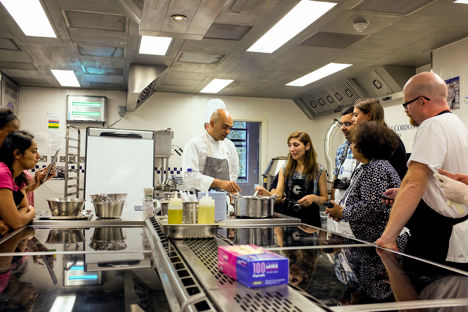
Cook school confidential: cooking with a tandoor oven
We teamed up with the amazing Alfred Prasad at Le Cordon Bleu to see how easy it is to achieve incredible results in the tandoor, and the secrets to getting the same charred flavour in a conventional oven at home.
Cook school confidential: cooking with a tandoor oven
We teamed up with the amazing Alfred Prasad at Le Cordon Bleu to see how easy it is to achieve incredible results in the tandoor, and the secrets to getting the same charred flavour in a conventional oven at home.
A true icon of Indian cuisine, the tandoor is part barbecue, part oven and is used to cook everything from pillowy naan breads to beautifully smoky and charred kebabs. While they might be hard to come across in the UK outside of professional kitchens, the history behind the cooking technique is fascinating and very similar results can be achieved in a conventional oven.
Alfred Prasad certainly knows his way around a tandoor, and loves the significance it had in shaping northern India’s cuisine. ‘Historically this style of cooking was brought to India by the Moghuls – the word kebab itself is actually Turkish and came from the Middle East,’ he explains. ‘It made its way into northern India and soon most villages had a communal tandoor. Everyone would make the dough for their bread and take it to this communal tandoor, sitting around in the evening chatting as it cooked. The tandoor is quite fuel hungry, so to have one in each household would have been quite a waste. The coals never really go out – overnight it would just be embers and perhaps cool down to 140°C, but in the morning it would just be topped up again.’
We invited Alfred to Le Cordon Bleu to host a masterclass on using the tandoor, showing bloggers and journalists why it’s such an incredible – and healthy – way to cook. ‘We’re cooking monkfish in a dairy-free marinade, using herbs and spices such as coriander, mint, lime leaf, turmeric, chilli and ginger,’ he says. ‘Most tandoor marinades are yoghurt- or cream-based so it doesn’t appeal to those with an aversion to lactose or dairy, so when I realised food intolerances were becoming more prominent it was important for me to start addressing that.’
Of course, a kebab needs some sides, and Alfred’s suggestions give the monkfish a cheffy edge. ‘I’m serving the kebab on a bed of kachumber salad, which is the quintessential summer dish in India. It’s just a brunoise of cucumber, red onion and tomato with oil and salt. On top is some samphire in an Indian tempura batter, so it’s very light and just flavoured with turmeric and toasted cumin seeds to give it a little twist.’ He also created a seawater foam, which is spooned on top of the fish for an extra salty kick.
‘Tandoors are always associated with breads and slapping naans on the sides, but with large skewers you can cook almost anything in them,’ explains Alfred. ‘Square or rectangular ones are great because food won’t slip round when you turn them, but with round skewers or if you’re cooking something with a high moisture content such as fish, put a raw piece of potato on the bottom to prevent ingredients slipping off. The middle third of the skewer is the perfect position to get the best heat, and heat transfers up the metal very quickly so it cooks from the inside as well.’
The heat of the tandoor means it cooks food incredibly quickly, and because the ingredients don’t touch the surfaces, very little oil is needed. ‘The tandoor can get up to 450°C, which is why most chefs who use it don’t have any hair on their hands or arms!’ says Alfred. ‘It takes many years to properly master the tandoor, as it requires being able to cook 100 naans in a busy dinner service as well as kebabs and anything else. Controlling the heat with the lid and being speedy is the key, and like every skill it takes a lot of time and dedication to become proficient.’
Of course, tandoors are hard to come by in the domestic kitchen, but Alfred has some tips on how to recreate the effect in a normal oven. ‘The monkfish kebab recipe can easily be done in a normal oven with a grill element,’ he explains. ‘Just thread the monkfish onto bamboo skewers that are long enough to balance on the edges of a roasting tin so the fish is hanging. Put it under a hot grill and try to turn them to get even colouring. If you can preheat the oven beforehand then you’ll get better results – the only thing you won’t be able to achieve is the smokiness, as there is no charcoal for the juices to hit and create smoke.’

